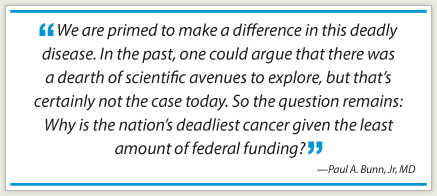 Despite growing national focus on early detection, prevention, and new molecular-based treatments, lung cancer persistently remains the number 1 cause of cancer death for men and women in the United States. The ASCO Post spoke to lung cancer specialist Paul A. Bunn, Jr, MD, Executive Director, International Association for the Study of Lung Cancer (IASLC), about current and future developments in the detection and treatment of lung cancer.
Despite growing national focus on early detection, prevention, and new molecular-based treatments, lung cancer persistently remains the number 1 cause of cancer death for men and women in the United States. The ASCO Post spoke to lung cancer specialist Paul A. Bunn, Jr, MD, Executive Director, International Association for the Study of Lung Cancer (IASLC), about current and future developments in the detection and treatment of lung cancer.
Lung Cancer Screening
The National Lung Screening Trial (NLST) provoked strong reactions. Is there more clarity about what the trial results mean for clinicians and their patients?
Currently, no. However, answers will come from further analyses of patients who participated in the National Lung Screening Trial and from numerous ongoing lung cancer CT screening trials that will ultimately bring insight into the value of lung cancer screening.
A 20% reduction in lung cancer mortality in heavy smokers over the age of 55 is incredibly important. However, 26% of patients in the National Lung Screening Trial had a suspicious nodule found on low-dose spiral CT, but only 4% of those nodules were cancer. So considering that the trial found 96% of suspicious nodules were benign, the major question is, how do we discern a benign nodule from one destined to become malignant?
The characteristics of the nodule (eg, solid, spiculated, calcified, ground glass) can help determine its potential for cancer, but with not nearly enough specificity. A study from Pittsburgh found that 30% of nodules removed for biopsy were benign, which is a lot of unnecessary workup and surgery. Add monetary costs and psychological toll on the patients, and it is difficult to justify. That’s why we need more definitive data on cost per life year gained and on improving diagnostic accuracy before widespread community adoption.
What do we do in the interim period, while we wait for better predictive capabilities?
Many organizations, like the U.S. Preventive Services Task Force, have been silent on this issue, indicating they don’t have enough information to make informed suggestions. The International Association for the Study of Lung Cancer suggests that patients who are concerned about developing lung cancer—for instance, those who have more than 20 to 30 pack-years of smoking and are over 55 years of age—should have a thorough conversation with their doctors to make an educated decision about the pros and cons of screening.
As the National Lung Screening Trial showed, the great proportion of suspicious nodules end up benign, but there was also a 20% reduction in mortality in screened populations. So, at this point, screening is a patient-by-patient decision.
Treatment Advances
Switching topics to treatment, is there anything in the current clinical landscape that seems promising, such as targeted biologics? Also, are we arriving at a better understanding of tumor markers?
 Lung cancers are heterogeneous, and there are four major histologic types, with some tumors having a mixture of histologies. We now have biomarkers to identify tumor histology. For example, if it’s adenocarcinoma, it usually has the protein TTF1, and squamous cell cancer usually carries the p63 protein. And if there’s an undifferentiated tumor, these two proteins help identify the histology.
Lung cancers are heterogeneous, and there are four major histologic types, with some tumors having a mixture of histologies. We now have biomarkers to identify tumor histology. For example, if it’s adenocarcinoma, it usually has the protein TTF1, and squamous cell cancer usually carries the p63 protein. And if there’s an undifferentiated tumor, these two proteins help identify the histology.
We’ve also learned that in many tumors—although they have an average of 300 mutations—one of those mutations might be driving the oncogenic process. If we can match the mutation with the tumor, we can give a pill that actually has better outcomes than chemotherapy. We’ve identified two mutations for which there are FDA-approved pills—EGFR mutations that respond to gefitinib (Iressa) or erlotinib (Tarceva), and EML4-ALK fusion, for which we would use crizotinib (Xalkori) therapy.
If we looked at 10 genes known to be oncogenic drivers for which there is a pill (only 2 are FDA-approved, but the 8 others are under investigation), 60% of these patients have 1 of these 10 genetic triggers. This tells us that patients are going to be getting different treatments based on the genetic properties of their tumor. The Lung Cancer Mutation Consortium tests for these 10 tumor markers and then puts patients on clinical trials based on individualized markers. So we are indeed making progress.
Smokers vs Never-smokers
Are we learning about the genomic differences in the tumors between never-smokers and smokers who develop lung cancer that will affect therapeutic strategies moving forward?
Yes and no. Smokers have more genetic changes in their tumors than never-smokers. However, the driver oncogenes identified so far are more common in never-smokers. Never-smokers have a better overall clinical outcome, and it’s likely that they have fewer mutations. Smokers can have the same driver mutations as well, so we are still going to have to test everyone.
Put simply, if we determine that a particular mutation occurs in perhaps 30% of the tumors in never-smokers but in only about 5% of smokers, and if it’s the best treatment for a particular cancer, we’re not going to exclude the 5% from testing.
Genetic differences between smokers and never-smokers who develop lung cancers provide an interesting scientific issue, but the clinical relevance is not as high as one might think. That said, further research is necessary.
Preventive Strategies
Do any current drugs look promising as preventive agents?
Foremost among preventive strategies is an aggressive national smoking-cessation message. However, half of U.S. lung cancers are in former smokers, so smoking cessation is not going to help that population. The best strategy for former smokers would be a fairly nontoxic chemoprevention pill. But getting approval for this indication would require lengthy clinical trials, and in reality we would need a biomarker to predict whether an agent is likely to prevent lung cancer.
We actually think that bronchial histology is an intermediate biomarker. In other words, smoking causes changes in the epithelial cells—hyperplasia, dysplasia, and some carcinoma in situ. Select lesions regress with smoking cessation, but many persist and subsequently undergo another genetic transformation and develop a cancer. The challenge is to develop a pill used to prevent the persistent lesions from mutating into cancer.
In 2011, we published a paper presenting data on iloprost, which showed preventive characteristics in persistent lesions.1 It wasn’t a large randomized trial with lung cancer as an endpoint. Histology was the endpoint, and the histology got better. Interestingly, it got better in former smokers, which is what you want, simply because there are too many carcinogenic issues in current smokers to sort out the drug’s preventive effect. It’s an exciting lead but will require a phase III randomized trial to show a reduction in lung cancers or a reduced risk.
Initiatives
Are there any initiatives underway at the International Association for the Study of Lung Cancer that you’d like to share with readers?
Lung cancer comes in one of four types, and we need to know the relationships among histology, molecular features, and outcome. About every 10 years, the World Health Organization changes the pathologic classifications. In the past, that’s been based on the appearance of cells under the microscope with no relation to molecular features. To that end, our pathology committee at the International Association for the Study of Lung Cancer is collecting data from thousands of patients worldwide to ascertain the relationship between the molecular features and clinical outcome.
Another initiative at the International Association for the Study of Lung Cancer involves staging. Naturally, staging becomes a more accurate clinical guide as we develop better tests. For example, there were no CT scans when the original staging systems were developed. Now we have PET-CT and brain MRI scans, and we can collect data from hundreds of thousand of patients to help create more accurate staging systems that better reflect outcomes.
Closing Thoughts
Any last thoughts on the state of lung cancer research?
As we know, lung cancer is the leading cause of cancer death in the United States, accounting for an astounding 30% of all cancer deaths in our nation. And yet, consider the research-funding bills recently passed by Congress. Appropriations for the Department of Defense, for example, include $120 million allocated for breast cancer, but only $12 million for lung cancer research.
We are primed to make a difference in this deadly disease. In the past, one could argue that there was a dearth of scientific avenues to explore, but that’s certainly not the case today. So the question remains: Why is the nation’s deadliest cancer given the least amount of federal funding? ■
Disclosure: Dr. Bunn has been a consultant with honorarium for Amgen, Bristol-Myers Squibb, Daiichi Sankyo, Merck, Agennix, AstraZeneca, Bayer, Boehringer Ingelheim, GlaxoSmithKline, Novartis, OSI, Sanofi-aventis, Pfizer, Eli Lilly, Genentech/Roche, GlobeImmune, Biodesix, Merrimack, and Celgene.
Reference
1. Keith RL, Blatchford PJ, Kittelson J, et al: Oral iloprost improves endobronchial dysplasia in former smokers. Cancer Prev Res 4:793-802, 2011.

